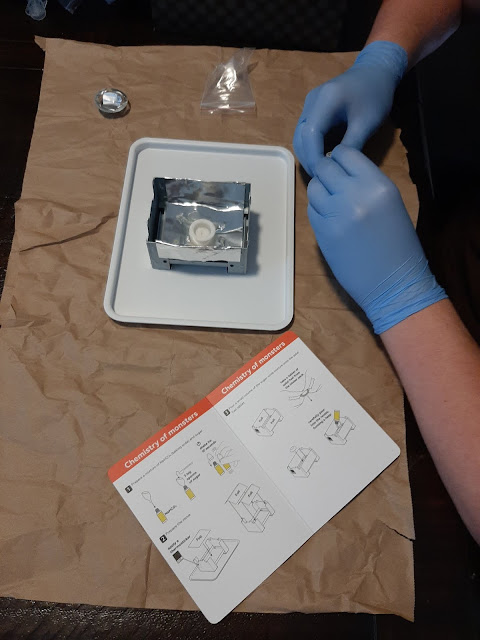- Ammonium carbonate x2
- Ammonium iron (III) sulfate x2
- Citric acid x2
- Potassium hexacyanoferrate(III) x2
- Film negative
- LED for blueprint x2
- Absorbent x6
- Battery holder
- Crocodile clip wire x2
- Double-ended spoon x4
- Experiment card x2
- Instructions
- Paper sheet x7
- Pin opener
- Plexiglass
- Protective gloves
- Transparent bag with valve x2
Monday, October 12, 2020
Chemistry in the classroom (Cyanotype-Mel Science)
Thursday, August 27, 2020
Marble Paper
We took paints and milk and created marble milk paper in the classroom this week. It was a lot of fun to see the designs that created with each sheet we ran through the milk/paint mixture. It's a simple process of one cup of milk and water colors, food coloring, or paint applied to the milk surface and a plain sheet of paper laid on top. We think the process would have been more uniform with acrylic paints/oil-based paints, but it was still a fun activity with what we used. We allowed the paper to dry in the sunshine.
Tuesday, May 12, 2020
Chemistry in the Classroom (Chemistry of monsters-Mel Science)
We recently started a subscription to Mel Chemistry and our first science experiment came in the mail this week. It's a chemistry lesson named: "Chemistry of monsters."
For one of the experiments it's a Sugar Snake. We used baking soda and sugar on a heated plate and grew a snake from the two. The chemical reaction with the soda, and sugar, when heat is applied was a good lesson in chemistry, for sure.
- Anthocyanin
- Citric acid x2
- Solid Fuel
- Sodium carbonate x2
- Sodium hydrogen carbonate x2
- Aluminum foil x5
- Double-ended measuring spoon x2
- funnel
- Liquid soap x2
- Protective gloves
- Syringe without needle
- Thermochromic sticker x2
- Wooden stick x4
- Experiment card x2
- Instructions
Sugar Snake: (Grow a black snake out of sugar!)













































